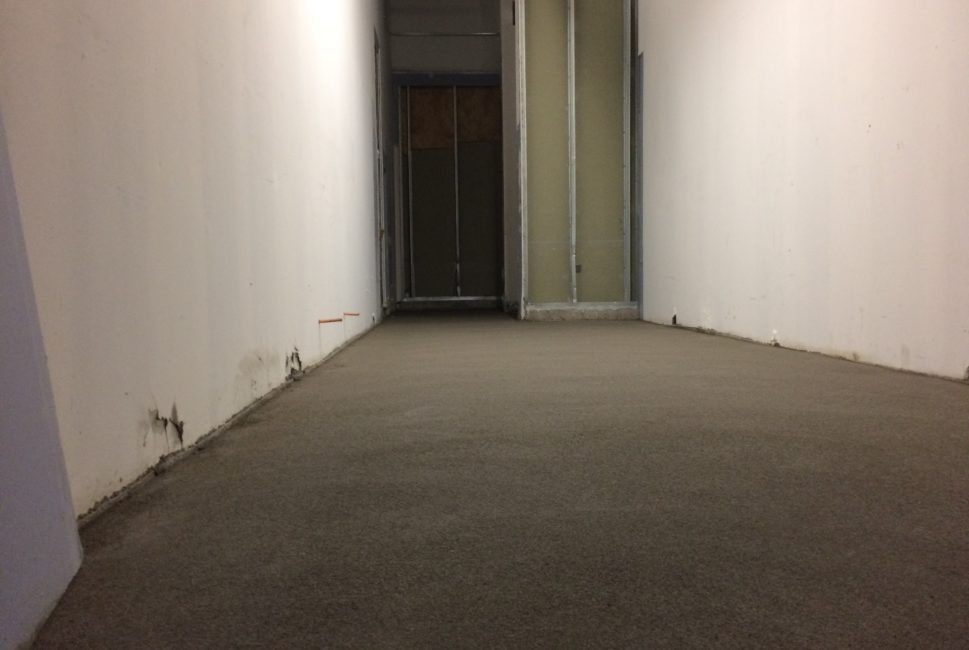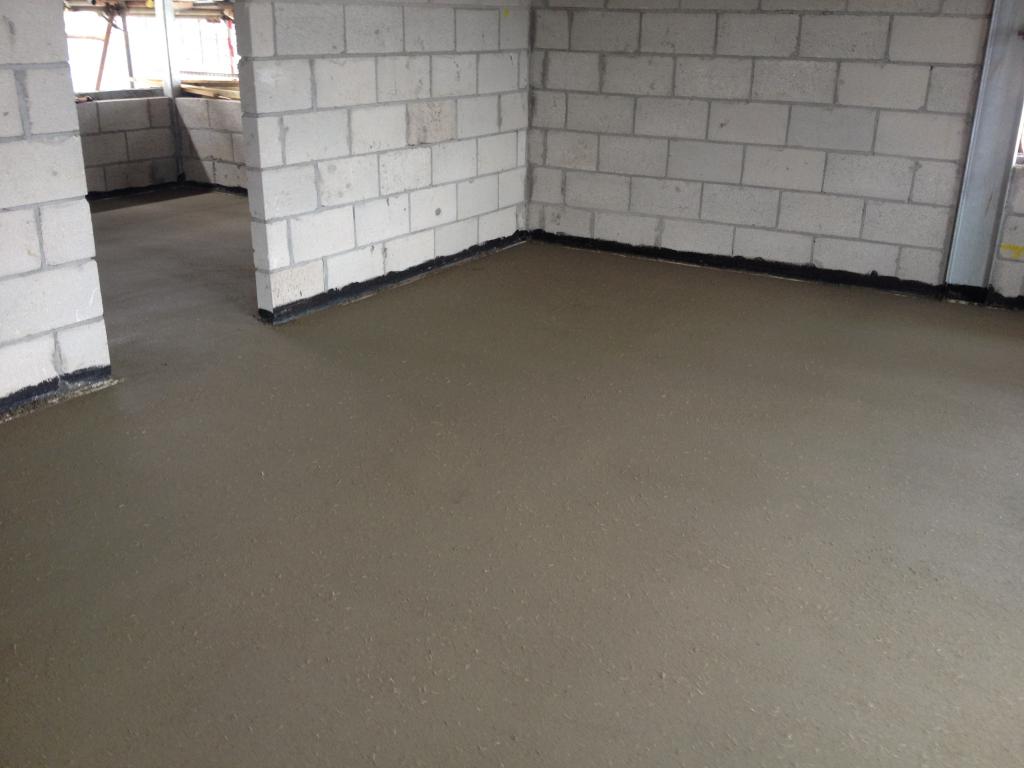The semi-dry screed device is similar to traditional concrete pouring or a special mixture. It can be used when leveling the rough surface, and after grinding it can be used as a finishing floor in non-residential premises. Since the composition of the mixture in the case of a semi-dry screed differs from the traditional one, the technology of filling itself changes. The essence of the method is rather well reflected in the name: the solution is mixed with a significantly smaller amount of water. Although the volume of the latter is taken to be minimal, it should be sufficient to hydrate the cement in the mixture. In its appearance, it most likely resembles wet sand, and not an ordinary cement mortar.
Pros of dry screed
The mixture, in which there is no excess water, hardening, as a result has not only less weight, but also simplifies the process of laying and leveling. However, these are not all the advantages of a semi-dry screed:
- The density, and hence the strength of such a mixture is higher than traditional. The absence of excess water reduces the amount of voids formed in this process. This also has a positive effect on the strength of the monolith.
- Such a mixture is almost not subject to shrinkage, which eliminates errors with its final thickness.
- A smaller amount of water in the mixture accelerates its solidification.
- Semi-dry screed technology is cleaner than traditional. In addition, the risk of a gulf of neighbors is reduced.
- The use of such a screed does not significantly affect the level of humidity in the room, and therefore does not adversely affect the quality of other finishing work.
On such a screed, you can walk freely after twelve hours after installation. Other finishing work in the room, excluding the application of finishing materials, begins in just a day. Less time passes before laying the final coating on the floor.
Disadvantages of semi-dry screed
But, like any method, a semi-dry screed has its drawbacks:
- A thick mixture does not spread well, which makes it very difficult to achieve clear angles, instead of which smooth transitions are formed.
- The complexity of manual laying semi-dry screeds in large areas.
- The minimum thickness of such a layer is three centimeters, and the optimal value is from four to five centimeters.
These shortcomings are not fatal and can be compensated. The negative effects of a high density mixture can be combated by adding plasticizers. Right angles between the walls and the floor are obtained by tamping.
Required screed thickness
Due to the absence of excess water in the mixture, the curing rate of such a screed is very high. If the laying thickness is less than necessary, it can dry faster than it grasps with the base of the floor. As a result, the hardened solution will peel off and quickly collapse under the influence of loads. A screed with a thickness of more than five centimeters will be very heavy, each extra centimeter adds up to 120 kilograms of weight per square meter. Therefore, if you need to raise the floor level, it is better to lay expanded clay or expanded clay concrete with the first layer, and only apply the solution to it.

In the process, it is better to use a floating floor scheme, in which the mixture does not directly contact either the base or the walls. Such a screed is separated from the rough surface by a waterproofing layer, and from the walls by polystyrene foam tape, which provides additional soundproofness. Another advantage of this composition will be that it does not transmit stresses arising in the construction of the house.
Dry screed reinforcement
To strengthen the semi-dry screed, reinforcement is used. Fiber fiber is becoming increasingly popular, which is gradually replacing the usual building mesh. This material has the following advantages:
- fiber is added to the screed at the stage of preparation of the mixture, which significantly reduces labor costs;
- reinforcing threads are evenly distributed throughout the volume of the solution, and strengthen the screed in all directions;
- fiber prevents the formation of cracks, while the grid only prevents their growth.
Using traditional fittings is less efficient. If for some reason it is necessary to use the grid, then this is done as follows:
- The first layer is applied up to three centimeters thick.
- Mesh sections connected by a wire are laid on it.
- A leveling layer up to two centimeters thick is poured on top.
Surface preparation
To ensure the durability of the floor, you must first prepare the base. First, surface defects are eliminated. The recesses are filled with cement mortar, and the protrusions are removed with a perforator. Then the floor is cleaned of debris, checked by level, and the level difference is determined by the level. The surface is lined with special material or durable polyethylene. It overlaps, and the joints are fixed with construction tape.

A damper tape no thinner than four millimeters is glued along the perimeter of the walls. Such a strip provides free movement of the entire structure, but also works as a soundproof material. To facilitate leveling the screed, beacons can be installed. For the device of the guides, a T-shaped metal profile is well suited. Lighthouses should be placed at regular intervals and fixed with cement mortar. When installing them, you need to focus on the longest wall, with a step slightly smaller than the rule indicates - it will be easier to level the mixture.
Solution Component Requirements
When calculating the amount of materials required for a semi-dry floor screed, first determine the allowable volume of the mixture, based on the area of the room and the thickness of the proposed layer. After that, you can proceed to the purchase of the main components:
- cement - it is better to choose a brand of 400 or 500;
- high quality sand (quarry or river);
- plasticizers to increase the fluidity of the mixture.
In the manufacture of the mixture, you can use some services and facilitate the process of working with a semi-dry screed. In the reviews, people note that in order to save time and energy when preparing the solution, it is worth renting a concrete mixer.
Some special requirements apply to the components of the solution. Sand should contain no more than 3% clay impurities, and various extraneous inclusions should be completely absent. Humidity can be any, but it must be taken into account when calculating the amount of water added to the mixture.
When buying cement, you should always pay attention to its expiration date and packaging integrity. Naturally, you should not save when buying cement of low grades. To prepare the solution, not all water is suitable. It is best to use tap water. Water from natural bodies of water requires verification before use, as it may be contaminated.
Mixture preparation
The dry mix is made on the basis of three parts of sand and one part of cement. Before adding water, the mixture is thoroughly mixed into dry. Water is taken in such quantity that the consistency of the solution is similar to sandy loam (sand with clay admixtures). Such a mixture should easily stick together in a lump, without releasing excess moisture. When reinforcing the screed with fiber, it should be added to the water before introducing it into the solution.
The natural moisture of the sand affects the consistency of the mixture, so when adding liquid, overflows often occur. In this case, dry components should be added to the solution, keeping their proportions.
Polypropylene fiber is added evenly to each bucket of water. This is necessary for its best distribution throughout the volume of the mixture. On one bucket of water you need to add a little less than a hundred grams of fiber, but its exact amount is better to learn from the manufacturer's markings on the package.
With machine preparation, you can immediately make all the necessary volume of the dry mixture. By mixing the solution manually, it is more correct to lay it out in layers. The first part of the mixture is rammed, after which the next is laid out on it. The finish layer is leveled with a rule and polished.
The mixture begins to dry in less than an hour after adding water. The disadvantage of a semi-dry screed is that when using this technology, all materials must be prepared in advance, and the work should be planned and carried out as quickly as possible.
Semi-dry screed
A layer of waterproofing is laid on the rough floor. For these purposes, you can use thick polyethylene, ruberoid or special material. The waterproofing strips are laid with an overlap, and the seams are fixed with construction tape. The material should go to the walls for fifteen centimeters, forming a pallet.
A polypropylene tape from a width of ten centimeters and a thickness of eight to ten millimeters is laid along the perimeter of the walls. The required screed height is marked on the walls with a level (normal or laser). The first layer of the solution is placed below the level of the beacons, and then rammed. Next, the second layer is immediately laid out, which is simultaneously rammed and leveled.
When the main work with a semi-dry floor screed is finished, they begin grinding. In rooms with an area of fifteen or more square meters along the walls, expansion joints are cut to a third of the depth of the leveling layer, and a width of not more than three millimeters. The laid screed is covered with a film and left to harden for a period of days to one week, depending on the conditions. In hot and dry weather, the surface with the drying solution must be moistened with water, otherwise it will dry too quickly, which can lead to cracking.
How much dry screed dries
When the solution dries, the surface does not shrink and you can start grouting immediately after leveling the floor with the rule. Then you need to wait for the final drying. Reviews of the semi-dry screed indicate that you can walk on such a floor in twelve hours, and in a day continue other finishing work.
Flooring can also be done earlier than with a classic grout. It should be borne in mind that this does not apply to all materials. Two days after the screed, you can lay granite and tile. Linoleum flooring is started in a week. A laminate or parquet can be laid only after a month, as in the case of a conventional screed.
Semi-dry screed: reviews
Opinions about this technology are rather controversial. Some people think this method is fast and effective, but they advise you not to walk on the floor for a week. People recommend paying attention to the quality of materials and the right proportions when making the solution. The quality of work depends on these indicators. It happens that they complain about unscrupulous manufacturers. Nevertheless, reviews about semi-dry screed are more positive.